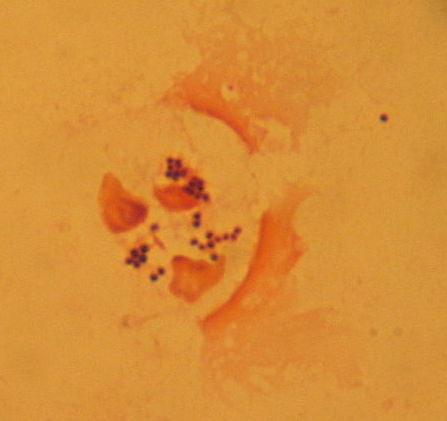WBR0846: Difference between revisions
Jump to navigation
Jump to search
Sergekorjian (talk | contribs) No edit summary |
Sergekorjian (talk | contribs) No edit summary |
||
| Line 24: | Line 24: | ||
[[Image:WBR0846.jpg|500px]] | [[Image:WBR0846.jpg|500px]] | ||
|Explanation=The image shown above is that of ''Staphylococcus aureus''. ''S. aureus'' is a gram-positive (violet color on gram-stain) coccus (circular shape) organized in clusters that resemble grapes. In fact, the Greek word "staphyle" means "grape". Staphylococcus aureus classically colonizes the anterior nares. Approximately 30-50% of individuals carry S. aureus in the anterior nares and are completely healthy. Other sites of S. aureus are also possible, such as in the throat. | |Explanation=The image shown above is that of ''Staphylococcus aureus''. ''S. aureus'' is a gram-positive (violet color on gram-stain) coccus (circular shape) organized in clusters that resemble grapes. In fact, the Greek word "staphyle" means "grape". Staphylococcus aureus classically colonizes the anterior nares. Approximately 30-50% of individuals carry S. aureus in the anterior nares and are completely healthy. Other sites of S. aureus are also possible, such as in the throat. | ||
|AnswerA=Rectum | |AnswerA=Rectum | ||
|AnswerAExp=Several organisms, such as Lactobacilli, can colonize the rectum. | |AnswerAExp=Several organisms, such as Lactobacilli, can colonize the rectum. | ||
| Line 37: | Line 37: | ||
|EducationalObjectives=''Staphylococcus aureus'' are gram-positive cocci that are arranged in clusters. The classical site of primary colonization is the anterior nares. | |EducationalObjectives=''Staphylococcus aureus'' are gram-positive cocci that are arranged in clusters. The classical site of primary colonization is the anterior nares. | ||
|References=Hu L, Umeda A, Kondo S, et al. Typing of Staphylococcus aureus colonising human nasal carriers by pulsed-field gel electrophoresis. J Med Microbiol. 1995; 42(2):127-32. | |References=Hu L, Umeda A, Kondo S, et al. Typing of Staphylococcus aureus colonising human nasal carriers by pulsed-field gel electrophoresis. J Med Microbiol. 1995; 42(2):127-32. | ||
Image attribution: Bobjgalindo. 2005. This file is licensed under the Creative Commons Attribution-Share Alike 3.0 license. | |||
|RightAnswer=D | |RightAnswer=D | ||
|WBRKeyword=Staphylococcus, Staphylococcal, Anterior nares, Colonization, Culture, Swab, Gram-positive, Cocci, Coccus | |WBRKeyword=Staphylococcus, Staphylococcal, Anterior nares, Colonization, Culture, Swab, Gram-positive, Cocci, Coccus | ||
|Approved=Yes | |Approved=Yes | ||
}} | }} | ||
Revision as of 23:14, 4 March 2015
| Author | [[PageAuthor::Yazan Daaboul, M.D. (Reviewed by Serge Korjian)]] |
|---|---|
| Exam Type | ExamType::USMLE Step 1 |
| Main Category | MainCategory::Microbiology |
| Sub Category | SubCategory::General Principles |
| Prompt | [[Prompt::In an experiment, a researcher obtains swab samples from 50 asymptomatic volunteers to detect the possible bacterial species that colonize uninfected individuals. He isolates several species and records his findings. Despite a significant similarily between recovered species, the growth of the bacteria shown in the image below was noted in approximately 25% of his subjects. Which of the following is most likely the site of colonization of the cultured organism? |
| Answer A | AnswerA::Rectum |
| Answer A Explanation | AnswerAExp::Several organisms, such as Lactobacilli, can colonize the rectum. |
| Answer B | AnswerB::Oral cavity |
| Answer B Explanation | AnswerBExp::Anaerobes, such as ''Actinomyces israelii'' colonize the oral cavity. |
| Answer C | AnswerC::Vagina |
| Answer C Explanation | AnswerCExp::Several organisms, such as Lactobacilli, can colonize the vagina. |
| Answer D | AnswerD::Anterior nares |
| Answer D Explanation | AnswerDExp::''Staphylococcus aureus'' colonizes the anterior nares. |
| Answer E | AnswerE::Nasopharynx |
| Answer E Explanation | AnswerEExp::Several bacteria can colonize the nasopharynx, such as Neisseria species, ''H. influenzae'' type B, ''M. catarrhalis'', and ''S. pneumoniae''. |
| Right Answer | RightAnswer::D |
| Explanation | [[Explanation::The image shown above is that of Staphylococcus aureus. S. aureus is a gram-positive (violet color on gram-stain) coccus (circular shape) organized in clusters that resemble grapes. In fact, the Greek word "staphyle" means "grape". Staphylococcus aureus classically colonizes the anterior nares. Approximately 30-50% of individuals carry S. aureus in the anterior nares and are completely healthy. Other sites of S. aureus are also possible, such as in the throat. Educational Objective: Staphylococcus aureus are gram-positive cocci that are arranged in clusters. The classical site of primary colonization is the anterior nares. |
| Approved | Approved::Yes |
| Keyword | WBRKeyword::Staphylococcus, WBRKeyword::Staphylococcal, WBRKeyword::Anterior nares, WBRKeyword::Colonization, WBRKeyword::Culture, WBRKeyword::Swab, WBRKeyword::Gram-positive, WBRKeyword::Cocci, WBRKeyword::Coccus |
| Linked Question | Linked:: |
| Order in Linked Questions | LinkedOrder:: |
